The History of Mother Shipton
A Legendary Myth or a Legendary Woman?
Very few verifiable details about the life of Mother Shipton are known. Even the time frame of her life and death can at best be approximated (often given as 1488-1561 based on historical references). Although many resources online and in book form claim to know authoritative facts about the intricacies of Mother Shipton's life, the origin of many of these "facts" are dubious in nature and have been called into question by historians.
Indeed many historians, even in Great Britain, are not convinced that
Mother Shipton is any more than a legendary, mythical figure. Skeptics continue to
rapidly and conclusively dismiss Mother Shipton as a "fraud" in the present day (and
have done so for over a hundred years). However, it is wise to be discerning regarding the logic,
agenda and depth of some of those critical analyses and whether they take into account varying
interpretations of the historical record.
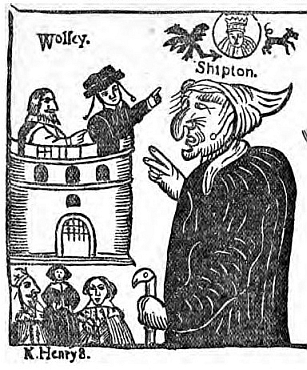
It is important to steer clear of an "all or nothing" approach when analyzing the older resources on Mother Shipton. Many sources clearly contain unreliable, indeed even intentionally fraudulent information, particularly since they were created during the dubious days of notorious "witch hunts". But there are also jewels of verifiable truth to be found in these very same sources. Just because a portion of an account is clearly embellished does not make the entire source a fraud. Too many people examining these sources completely dismiss them, ignoring important clues.
When it comes to studies of Mother Shipton, one British historian stands apart from all the rest. His name is Dr. Arnold Kellett (1926-2009), a historian from Yorkshire, England who dedicated ten years of unbiased, in-depth research and detective work into the life of Mother Shipton. If you are seriously interested in the history of Mother Shipton, there is absolutely no comparison to Dr. Arnold Kellett's insightful, unbiased, well-researched book Mother Shipton ~ Witch and Prophetess (2002). Dr. Kellett lived in the very area of England said to be the home of Mother Shipton, and he spent many years researching and writing about not only her life, but also the history of the area, including Knaresborough and York.
Although Dr. Kellett calls into question many commonly accepted "facts" regarding Mother Shipton and tends to be quite skeptical regarding several of the prophecies attributed to her, he does make an excellent, academically-sound, logical case for her existence. He also is able to make an insightful historically-based case that at least a couple of the prophecies attributed to Mother Shipton did indeed appear to exist before the actual events prophesied. In another case, he points out details that are missing from an important early prophecy that would almost certainly have been present if concocted later with hindsight. Dr. Kellett received a prestigious award from fellow historians in Great Britain for the depth of his research, notable since many historians do not take Mother Shipton seriously as an actual person, any more than they might contemplate the history of Merlin.
This web site will endeavor to set the record straight on the history of Mother Shipton, pointing out where many accounts of her life go astray or leave out key details, including the occasional "authoritative" references in various doomsday documentaries on television these days. A wide array of resources are being studied as this site evolves, including a special emphasis on the work of Dr. Kellett in gaining an accurate understanding of the historical record. Because this web site is not just a clinical study and is written with an awareness of the reality of spiritual phenomena, the door to mysterious possibility will remain open, something that will be particularly apparent when exploring the prophecies. This balance of logic and spirituality is proving to be a catalyst for the development of original theories only to be found on this site, especially with regards to some of the prophecies.
What's in a Name?
Most web sites and books on Mother Shipton will begin by telling you definitively that her name actually was Ursula Southeil, Ursula Sonthiel, Ursula Southill, Ursula Soothtell, or some variation thereof. In truth, it has not yet been historically verified if these names have anything at all to do with the real Mother Shipton.
Early accounts of Mother Shipton relied heavily on embellishing her "witch-like" attributes, and as Dr.
Kellett points out in his work, the name "Ursula" was a name shared by other famous witches of the day
and could easily have been conveniently assigned to Mother Shipton by a writer seeking to embellish her "witch-like" history.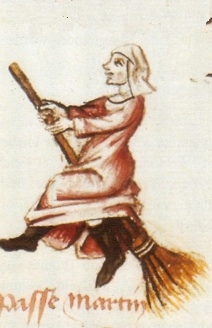
Likewise, the name "Soothtell" has obvious "witch-like" connotations, suggesting a fortune teller. These first and last names (beginning with the coincidental "Soothtell") first showed up in a single pamphlet written in 1686, with no earlier reference. This particular resource, The Strange and Wonderful History of Mother Shipton, was essentially a re-release of an earlier 1667 book, yet with some interesting additions, including the introduction of these two new names. It claims Mother Shipton was baptized by a nearby bishop as Ursula.
Would such a "coincidence" render it impossible that Mother Shipton's maiden name was some variation of Ursula Soothtell? Anyone in the spiritual community familiar with the concept of synchronicity knows that such statistically unlikely "coincidences" can indeed take place.
Something else even more compelling that needs to be considered is how names in the past often identified the trades of the people in question. This is something Dr. Kellett failed to take into account when exploring the supposed coincidental nature of the maiden name "Soothtell". Keep in mind that it is indeed "Soothtell", not any other variation of that name, that was first mentioned. If one wants to make a speculative case regarding how that name could have originated, or even the name Ursula, all one needs to do is consider OTHER trades expressed in names - names like "Miller", "Smith", etc., names calling attention to a family trade.
Is it possible that "soothtelling" ran in Mother Shipton's family? We know very little about her mother, but what if her mother was a "soothteller" too? Could her father have had "soothtelling" ability? Could this name have been passed down through the generations, identifying a particular family talent, no different than a "miller" or a "blacksmith? Even the name "Ursula" might be given to a promising child in a soothtelling family. It need not be a coincidence at all. But we cannot know for sure.
The name Shipton shows up earlier than any reference to Soothtell, with its first known historical reference from 1641 in a pamphlet by Lownds, still many years after her death, where she is referred to as "Shipton's wife". A very popular (though not always accurate) account of Mother Shipton's life first published in 1667 by Irish writer Richard Head assigns the name "Shipton" to Agatha Shipton, in this account said to be the mother of Mother Shipton. And one cannot discount the oral tradition surrounding Mother Shipton, begun by many who were illiterate around the time of her lifetime and kept alive until the present day.
Early resources mention Mother Shipton marrying a builder or a carpenter, including the pamphlet distributed by Conyers, which says she married a carpenter named Toby Shipton. One of the highlights of Dr. Kellett's historical detective work is his discovery in the local records of York Minster an invoice for planks of wood referencing a carpenter with the last name of Shipton working in the area in the late 1400's. This particular carpenter has the first name of Laurence, but it is possible he could have had some relation to a Toby (whose name cannot be found), with carpentry being passed on as a family trade. There is also a village by the name of Shipton only 4 miles north of York, very close to where this work would have been performed. Was the town of Shipton named after the very family associated with the carpenters Laurence and Toby Shipton? We cannot know for sure.
Something Dr. Kellett does not speculate about is whether the confirmation of a nearby carpenter named Shipton lends any more credibility to the OTHER information introduced by Conyers in 1686, including the maiden name "Ursula Soothtell", since Conyers appears to be the first to mention that Mother Shipton's husband is a carpenter.
Until more reliable information comes to light regarding any other name, this web site will refer to Mother Shipton simply as "Mother Shipton".
There's No Place Like Home
Accurately locating the home of Mother Shipton is not quite as easy as many web sites and books suggest. Although
this may seem unusual to those outside of the United Kingdom,
the legendary Mother Shipton has quite a tradition as a tourist attraction in the U.K., with
multiple areas
claiming 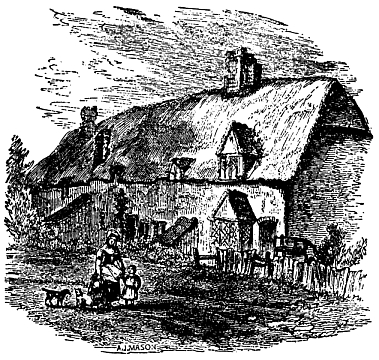 at least
some
portion of her life. It is also not inconceivable that she could have moved more than once within her lifetime,
depending on the nature of her husband's work and the resources they had available to them.
at least
some
portion of her life. It is also not inconceivable that she could have moved more than once within her lifetime,
depending on the nature of her husband's work and the resources they had available to them.
The most popularly attributed locale associated with the birth of Mother Shipton is in or near a cave by the Dropping Well in Knaresborough, Yorkshire, even though there are areas claiming her as far away as London, Scotland and Wales. A modern-day resource (and others derived from that source) even suggests her family eventually ended up in Australia, though there is no way to confirm that.
A common drawing of "Mother Shipton's house" one often finds online and in print actually originated in 1852 in a place called Winslow-cum-Shipton in Buckinghamshire, quite a bit farther than Knaresborough from the likely locale of some of the most famous and verifiable prophecies. Though somewhat unlikely for a woman of modest means in the 1500's, it is not easy to know if she may have lived in multiple locations within a lifetime, particularly if her husband was a carpenter.
And then of course we have the town of Shipton itself near York, already mentioned in the previous section. That coincidental name cannot be discounted either, though it may just be the origin of Mother Shipton's husband, not necessarily the place they lived.
Some of Mother Shipton's earliest prophecies involve the Archbishop Wolsey of York, placing her in an area somewhat outside of York, yet not too far away. Whether the town of Shipton would fit the specific geographical characteristics involved in the most famous of these prophecies is yet to be verified. Dr. Kellett mentions that there is a reference to a location of Mother Shipton's tombstone in Richard Head's book, suggesting it was a mile away from York on a road that leads to the town of Shipton. Numerous people have tried to find Mother Shipton's grave in the present day, but it is yet to be located. There is also some speculation that Mother Shipton may have actually lived in York itself.
Other prophecies attributed to Mother Shipton involve the Siege of York in 1644 and references to the Ouse Bridge and Trinity Church in York, suggesting she did indeed live somewhere in the area.
But before we digress too much, let's return to an examination of the most popular notion regarding Mother Shipton's alleged birthplace at a very famous cave near the magical waters of the Dropping Well (also sometimes called the Petrifying Well). Although "Mother Shipton's Cave" is now a popular tourist attraction in Knaresborough, there are unfortunately no early references to the cave, and there is a high likelihood the cave did not exist at all during the time Mother Shipton lived. The famous cave is entirely missing from a 1746 engraving of the Dropping Well. A cave does of course exist at the site in the present day. We can only speculate regarding how it was formed or exposed and why it is not referenced earlier.

Even more interesting is the fact that there are scant references to Mother Shipton's association with the Dropping Well in any number of detailed accounts of visitors to the area. This is often mentioned as a reason why Mother Shipton may not have existed at all, but what it actually could suggest is that the association with the Dropping Well itself is the legend, not the reality of her existence.
The Dropping Well is the oldest tourist attraction in England. Its claim to fame is the ability to turn common objects to stone, and visitors have been marveling at the magical qualities of the flowing, petrifying water here for centuries. The water is actually not magical at all ~ its high mineral content is what does the trick, but even so, it has been delighting and mystifying visitors for a very long time.
Although we cannot know for sure if Mother Shipton might have lived near these unusual waters, it is highly likely that her association with the idea of turning things to stone was yet another fabrication emphasizing classic, not necessarily complimentary "witch-like" attributes, a popular myth going at least as far back as Medusa.
With that said, there are some resources which do plausibly suggest Mother Shipton lived in or near Knaresborough, very close to the modern-day cave. See the section "A Witch, an Archbishop and a Fateful Encounter: The Mother Shipton Legacy Begins" for a discussion of an encounter Mother Shipton is said to have had with noblemen and a magistrate known to be living in the area. We can once again all thank lifelong Knaresborough resident and historian Dr. Arnold Kellett for some very astute detective work in this regard, though precise, completely verified conclusions are difficult to come by.
It is important to note that near the Dropping Well is the site of a very famous spa at Harrogate where healing waters have been known to be present since the sixteenth century. Is it possible Mother Shipton walked near these healing waters, perhaps assisting her neighbors with naturally derived cures? We cannot know for sure, though it would be tempting for some to surmise that "a witch" (or even an intuitive healer) would indeed have something to do with the area.
Ultimately all we can really know about Mother Shipton is that she likely lived in the vicinity of Yorkshire due to her prophecies related to that area. The exact location may never be known with certainty.
Concocting a "Dreaded Witch" ~ The Oft-Repeated Tall Tales of Mother Shipton's Birth and Childhood
On page after page after page regarding Mother Shipton, you will find repeated "facts" from a very early account of her life created at a time when all sorts of fantastic stories were being concocted about "witches". Unfortunately, these things have been repeated for so very long that their dubious origins have been obscured.
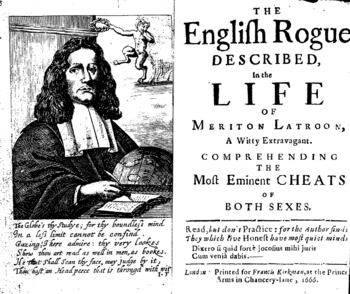 Almost all of the embellished history of Mother Shipton originated with the writings of Richard Head, known for flights of fancy in his writing, creating the 17th century equivalent of tabloid reporting today (even more dubious back then). Excerpts from his 1667 book The Life and Death of Mother Shipton have been quoted without attribution or analysis for centuries.
Almost all of the embellished history of Mother Shipton originated with the writings of Richard Head, known for flights of fancy in his writing, creating the 17th century equivalent of tabloid reporting today (even more dubious back then). Excerpts from his 1667 book The Life and Death of Mother Shipton have been quoted without attribution or analysis for centuries.
Mr. Head's primary claim to fame as an author was actually a personal account of his life as "an English rogue", all about his dealings with shady characters of his day. His writing was viewed more as scintillating entertainment than factual, frowned upon by censors. Dr. Kellett describes Mr. Head's work as "inclined to sensationalism, fantasy and downright deception...he can rarely be taken at face value".
Fabricating amazing, horrifying stories about "witches" was a popular pursuit during this time frame, with a dark history going back to The Malleus Maleficarum ("The Hammer of Witches") of 1487, a notorious document filled with falsehood that is reputed to have contributed to the deaths of up to 60,000 victims by the time the centuries of witch-hunting fever had passed.
Although Richard Head's account of Mother Shipton appears on the surface to have been more playfully fanciful than intentionally malicious, it nevertheless fed upon the same witch-hunting frenzy and commonly repeated tales about "witches" that had been popular for two hundred years.
Since many visitors to this site have no doubt been to others, or perhaps have read any
number of accounts in books on Mother Shipton, we will step through all the "facts" that
actually originated with none other than Richard Head, so that perhaps people will stop
repeating such things so authoritatively. It is not at all difficult to discern why these
things are not to be trusted, once you view them within the context where they appeared.
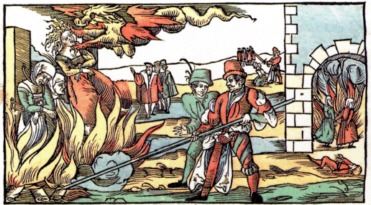 All it takes is
a cursory knowledge of "witch hunting history" and some common sense, when you trace these "facts"
to their source.
All it takes is
a cursory knowledge of "witch hunting history" and some common sense, when you trace these "facts"
to their source.
Richard Head's account of Mother Shipton's origins begins with a tale of a fallen woman, a popular place to start when writing of "witches" in his day. Mother Shipton's orphaned fifteen-year-old mother "Agatha Shipton" was said to have cavorted with the Devil who tricked her into the worst of behavior in exchange for the elimination of her destitute circumstances. Note that it's already unlikely Mother Shipton's mother would have the same last name, especially since there is an earlier reference to her as "Shipton's wife".
The Devil allegedly shares all sorts of evil secrets with Agatha, turning her into a witch. She is told she will be able to shapeshift, change the weather, tell the future and the past, heal or destroy. She even is transported by a chariot conveyed by dragons, her lowly apparel and surroundings instantly transformed.
Anyone who has studied anything about the witch hunts in this time of history and the popular stories of the day will quickly recognize many familiar elements. Agatha is also accused of casting many nasty spells to vex her critical neighbors, with stories of other fantastic creatures, including being delivered by dragons from her witch trial.
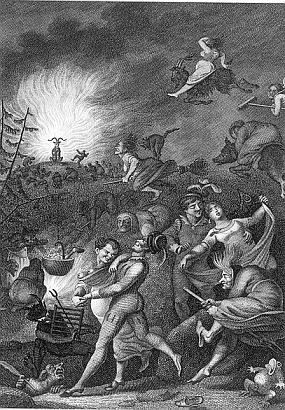 Agatha's unseemly
behavior with the Devil of course is then said to lead to the birth of her "Devilish Offspring",
suckled by an evil "tet" grown from an incantation by her mother, a child who quickly exhibits all
sorts of amazing behavior worthy of her supposed birthright. Unfortunately most accounts of Mother
Shipton today report the behavior described as reliable stories, with no knowledge or mention of the
source. There is only one source if you choose to look - and it is unfortunately the unreliable,
sensantionalistic Richard Head.
Agatha's unseemly
behavior with the Devil of course is then said to lead to the birth of her "Devilish Offspring",
suckled by an evil "tet" grown from an incantation by her mother, a child who quickly exhibits all
sorts of amazing behavior worthy of her supposed birthright. Unfortunately most accounts of Mother
Shipton today report the behavior described as reliable stories, with no knowledge or mention of the
source. There is only one source if you choose to look - and it is unfortunately the unreliable,
sensantionalistic Richard Head.
Do you believe all the accounts from the Salem witch trial accusers as reliable fact? That would be a nice comparison. It is so very important to understand the context of the times and the incredible tales being told of witches.
Have you heard accounts of Mother Shipton's hideous appearance at birth? Her huge crooked nose? Pimples of many colors? Her extreme physical deformities? Her strange glowing features? You can thank Richard Head for that too. And hopefully you now already can see why he isn't exactly a storyteller to be trusted.
Have you heard Mother Shipton had amazing powers as a child? Levitating herself as a baby up the chimney? Moving objects at will? Tricking the schoolmates who teased her with stunning supernatural skills? All due to the notorious Richard Head. You'll find such oft-repeated "historical" accounts in their actual historical context right next to "trustworthy" tales of her father the Devil coming to visit her in various animal forms.
Truth be known, many of us have been sold a bill of goods about Mother Shipton's "witch-like" past, and we have Richard Head and the hysteria of the time to thank for that. Perhaps it's time to find the REAL woman hiding behind these superstitious tales.
And what we must first acknowledge is that we actually know virtually NOTHING about her origins, birth, childhood or physical appearance, not one fact from a reliable source. Is it possible that SOME of these stories have at least a little basis in truth? Is it possible she was indeed a gifted child? Of course it is possible, but it is more probable that very little, if anything, is known of her youth. Thankfully that is NOT quite the case with the REST of her story...
A Witch, an Archbishop and a Fateful Encounter: The Mother Shipton Legacy Begins
Independent of fantastic stories about her childhood, many believe that Mother Shipton reached legendary status much later in life - through an infamous prophecy that spread far and wide.
The story of a prophetess begins with the story of an Archbishop, the very same man who was demoted from the lofty office of Cardinal in 1529 for failing to obtain the Pope's dispensation to annul the marriage of Henry VIII to Catherine of Aragon.
Forced to forfeit his Cardinal title and his property, Cardinal Thomas Wolsey was demoted to a role he had largely ignored, the Archbishop of York, to which he was to travel in exile from the Court. His destination was Cawood Castle, the Archbishop's residence eight miles south of York, and he was to be formally recognized as Archbishop with all manner of the pomp and circumstance he demanded on November 7, 1530.
A nasty rumor was said to reach the ex-Cardinal's ears, a rumor of a dire prophecy uttered
by a little-known Yorkshire woman thought to have the second sight. According to what might be
a prophecy or a curse, it was said the Archbishop would never reach
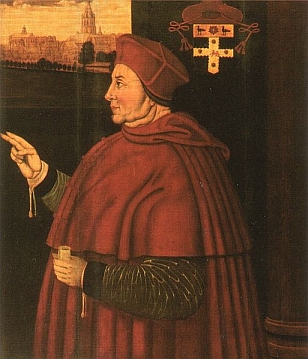 York at all.
York at all.
There were said to be mixed feelings in York regarding the Archbishop's return, as he had largely ignored his role as Archbishop in favor of the much more lofty position as Cardinal. A rumor of his coming demise would no doubt have been of interest to supporters and critics alike.
If indeed there was a seer in the area trusted by those around her, a rumor such as this was likely to travel...and travel...and travel, as such juicy rumors do - until against all odds, it reached the ears of the demoted Cardinal himself.
In that day and age, prophecies from "witches" were never treated lightly, especially a prophecy able to travel so far. Prophecies of witches were to be feared, as the witch might have the power to transform the prophecy into a self-fulfilling curse.
The Archbishop of course reacted in the customary way. He angrily proclaimed he would burn this woman when he arrived in York, a commonwoman who dared to curse a prelate far above her station. The only fate for such a "witch" could be the fire.
It is said that an investigation was rapidly launched, the prophecy deemed so very threatening that three noblemen were immediately dispatched to find the Yorkshire witch and verify the rumor. In this illustrious company were Henry Grey, 1st Duke of Suffolk (and the father of Lady Jane Grey, who later became an ill-fated queen), Thomas Percy, 7th Earl of Northumberland, said to be near Knaresborough a the time, and Thomas D'arcy, Steward of the Honour of Knaresborough, the likely resident of Knaresborough Castle.
The men were accompanied by someone named as a "Master Besley", who apparently was aware of where the woman lived. It is to the credit of Dr. Kellett's research that he was able to verify the existence of someone named Reynold Besely, a local magistrate in Knaresborough at the time, someone with access to local records and who may have even been familiar with the woman herself. This woman was of course Mother Shipton, and this account appears in the very first pamphlet written about her life in 1641. The existence of a magistrate named Besely of lends credibility to the account.
In reference to the previous section regarding Mother Shipton's home, it seems meaningful to note the very direct relationship at least three of these men had at the time to the vicinity of Knaresborough, perhaps boosting the likelihood Mother Shipton DID live in Knaresborough at the time, though we may never know with certainty.
According to the 1641 account, Mother Shipton was quite magnanimous in welcome, answering the knock at her door with "Come in Master Besley and those honourable Lords with you." Apparently "this they thought strange, that she should know them and never saw them."
One could also reasonably surmise that dear Mother Shipton was warned by friends, as noblemen traveling with a magistrate in search of her home could hardly travel without notice, especially if their intent might be to drag her to the stake. It is said Mother Shipton was well-liked by those around her, so friends would no doubt warn her if they could.
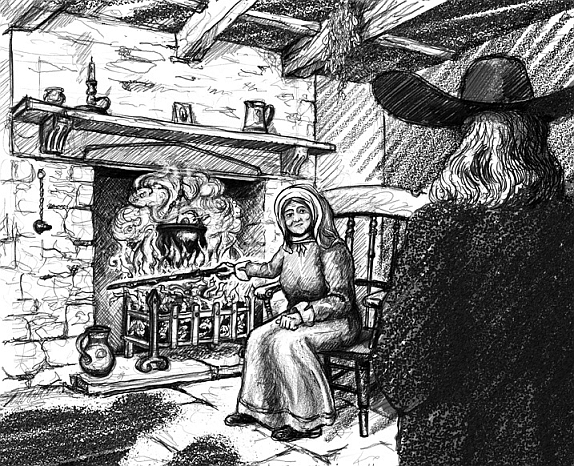 The wise and
hospitable Mother Shipton was said to have "a great fire" going. She "bade them welcome,
calling them all by their names", and served the men cakes and ale, such that the men became "very merry".
The wise and
hospitable Mother Shipton was said to have "a great fire" going. She "bade them welcome,
calling them all by their names", and served the men cakes and ale, such that the men became "very merry".
"Mother Shipton, if you knew what we come about, you would not make us so welcome", Duke Henry Grey was said to remark. Her response, according to the 1641 pamphlet, was "the messenger should not be hang'd".
One can see the wisdom and serenity of Mother Shipton in this response, having the common sense to know that these men were not at fault for whatever fate might befall her. She knew the men were no more than carriers of a message, and given they might fear her as a witch, it is significant that she made it clear she intended them no ill will.
The Duke then mentioned the rumor itself, that "the Cardinall shoulde never see Yorke". To this, Mother Shipton unflinchingly replied, "I said hee might see Yorke, but never come at it"
Seemingly astonished that this warm and friendly woman would immediately confirm the dangerous prophecy in question, even expand upon it, the Duke warned Mother Shipton the demoted Cardinal would not hesitate to burn her at the stake if she continued such dangerous utterances.
To this dire warning, Mother Shipton was said to boldly respond "Wee shall see that", tore the kerchief off her head and tossed it into the fire. It is at this point that the story ventures into legend, and we may never really know what actually happened that day. It is said the kerchief didn't burn at all. Then she took "her staffe" and placed it in the fire, its wood completely untouched by the roaring flames.
Mother Shipton was said to pull both items from the fire unscathed, with the remark "If this had burn'd, I might have burn'd."
At this point, the conversation shifted, as the gentlemen, naturally impressed with this wondrous woman, and no doubt still in good spirits from the ale, realized this was a rare opportunity for a fortune telling session with a bonified soothteller.
Pleased to comply, as one can only surmise this prescient woman often did this for her neighbors, Mother Shipton unfortunately had some rather bad news to share. Some say the prophecies she is said to have issued almost surely were forged and attributed to her after the fact, but Dr. Kellett raises a very astute point in his analysis, noting that she left out some key details that surely would have been irresistible for a forger to include. We will scrutinize these prophecies in more detail in the evolving Prophecies section and summarize the key points here.
To Henry Grey, the Duke of Suffolk, Mother Shipton said "My love, the time will come when you will be as low as I am, and that's a low one indeed." This prophecy did indeed come true, though it makes no mention of Henry's daughter Jane later becoming queen not in small part through her father's influence at Court. Ultimately, Lord Grey became one of many executed victims of the infamous Queen "Bloody" Mary, beheaded on February 23, 1554 after being accused of high treason.
Indeed, perhaps for the very first time on this web site associated with the prophecy of Mother Shipton, a morbid discovery in 1851 may indicate just how "low indeed" Henry Grey descended. Documented by an account and photograph in the 4th edition of Unknown London, 1922 by Walter George Bell, the Duke's mummified head is said to have been discovered in a vault hidden UNDER the unassuming Church of the Holy Trinity. It was thought to have been secreted away by his widow to the chapel where they both may have worshipped, saving it from the humiliating, horrendous public display on a pike, a common practice at that time.
There is yet another way Henry Grey was deemed to be 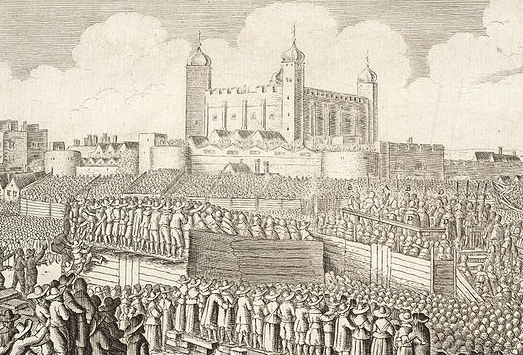 "a low one indeed", as some
of his actions and statements at the time of Queen Mary's ascension to the crown were thought to be cowardly
by the new Queen and his countrymen. For more on the prophecy related to Henry Grey, see
the Prophecies section of this web site (where more details will be
added soon).
"a low one indeed", as some
of his actions and statements at the time of Queen Mary's ascension to the crown were thought to be cowardly
by the new Queen and his countrymen. For more on the prophecy related to Henry Grey, see
the Prophecies section of this web site (where more details will be
added soon).
Something historically notable about the Henry Grey prophecy is its relation to Mother Shipton herself. There has been some debate regarding whether Mother Shipton was a commonwoman or a woman of some means. The latter is due to some writings about Mother Shipton referring to her having a servant. Generally people seem to gravitate, however, towards her being a commonwoman, and in her own words to Henry Grey, she appears to verify her "low" station in life compared to his. Dr. Kellett also points out that her use of the word "love" is very consistent with the commonwomen of that time and place.
Unfortunately, Henry Grey wasn't the only Lord present on that fateful day in Mother Shipton's home facing a bleak and headless future. To Lord Thomas Percy, Mother Shipton allegedly had the following to say: "Your body will bee buried in Yorke pavement and your head shall be stolne from the barre and carried into France."
This prophecy in particular has been questioned due to its uncanny accuracy, seemingly indicative of a forger's pen after the fact. But what we do know from history is that Lord Thomas Percy was executed by Henry VIII in 1537. People writing about his execution later claimed that he was beheaded on a scaffold standing on pavement, his body was buried separately from his head, which (unlike Henry Grey's) was displayed on a pike, only to be stolen and taken to France.
As for Lord Thomas D'arcy, Mother Shipton's prediction was not so direct (in itself an indication it was likely not written after the fact): "You have made a great Gun, shoot it off, for it will doe you no good, you are goinng to warre, you will paine many a man, but you will kill none."
Lord D'arcy did indeed go to war, was labelled a rebel along with his friend Lord Percy, and he too was executed in 1537. Dr. Kellett notes that it is indeed interesting that so little detail was included regarding Lord D'arcy, a response to critics suggesting all these prophecies were forged long after the events they foretold took place.
Their warning delivered, the four men left Mother Shipton alone that day, indeed proving to be no more than messengers intending her no harm. And one can only surmise they came to like this kind woman who welcomed them into her home, though her fortune telling did not bode well for their fates.
And whatever became of the illustrious Archbishop? As he was traveling closer to York, he supposedly inquired of those with him regarding the ill-fated prophecy, reminded of its claim he might see York, but never arrive. As the 1641 account tells it, "He vowed to burne her when he came to Yorke. Then they shewed him Yorke, and told him it was but eight miles thence; he said he will soone be there; but being sent for by the King hee dyed in the way to London."
The Archbishop had indeed been called back to London - to face a charge of High Treason from Henry VIII. But he never made it back to Court to face his accuser. It was said he acquired some type of dysentery, and that was indeed his demise. He never made it to York either (though he may have seen it in the distance), just as was foretold.
The blustery Archbishop never had the chance to burn a gentle commonwoman by the name of Mother Shipton, whose legendary status was said to be truly born on the day of his demise - a reputation that continued to grow, all the more enhanced by the fates of the kind noblemen who visited her one fateful afternoon. Surprisingly there is no indication in the historical record of any retribution - perhaps because the tempestuous Archbishop's death may have been welcomed more than mourned.
And this prophecy was just the beginning...
MotherShipton.com is part of the ongoing The Prophetess Legacy ~ Feminine Voices of the Divine research project created by Susan Larison Danz.
